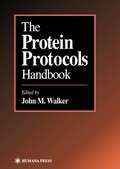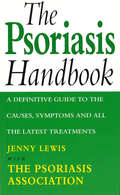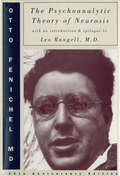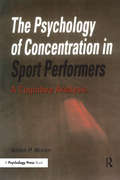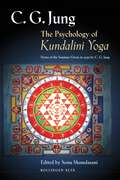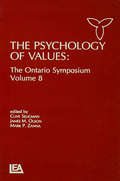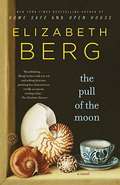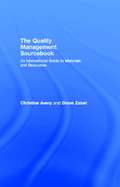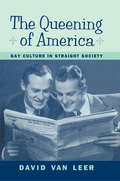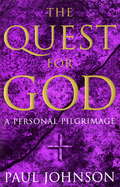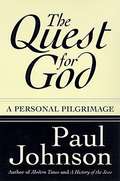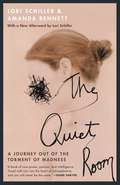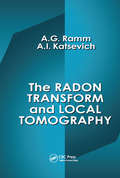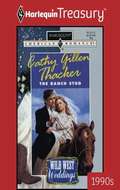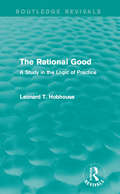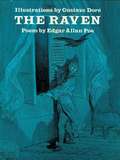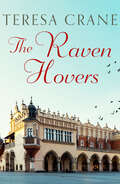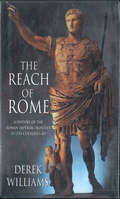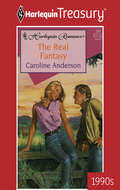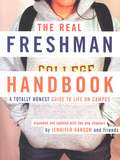- Table View
- List View
The Protein Protocols Handbook
by John M. WalkerIn The Protein Protocols Handbook, I have attempted to provide a cross-section of analytical techniques commonly used for proteins and peptides, thus providing a benchtop manual and guide both for those who are new to the protein chemistry laboratory and for those more established workers who wish to use a technique for the first time. We each, of course, have our own favorite, commonly used gel system, g- staining method, blotting method, and so on; I'm sure you will find yours here. However, I have also described a variety of alternatives for many of these techniques; though they may not be superior to the methods you commonly use, they may nevertheless be more appropriate in a particular situation. Only by knowing the range of techniques that are available to you, and the strengths and limitations of these techniques, will you be able to choose the method that best suits your purpose.
The Psoriasis Handbook: A Definitive Guide to the Causes,Symptoms and all the Latest Treatments
by Lewis , Jenny With The Psoriasis AssociationPsoriasis is a common and sometimes painful skin condition affecting more than 1. 5 million people in Britain. Brought to most people's attention in Dennis Potter's THE SINGING DETECTIVE, it can vary in severity from simply being a mild nuisance to being so bad that the sufferer has to be admitted to hospital. With no known longterm cure, this comprehensive guide seeks to give practical help to all age groups, describes the different types of psoriasis and lists the possible causes. Following the style established by Jenny Lewis's three previous titles, THE PSORIASIS HANDBOOK contains invaluable case histories showing how individuals cope with psoriasis, as well as the various treatments available. Packed with essential information, THE PSORIASIS HANDBOOK is THE guide for suffers, friends and relations.
The Psychoanalytic Theory of Neurosis
by Otto Fenichel Leo RangellA perennially best-selling and influential psychoanalytic work. When Otto Fenichel died suddenly at age 48, Anna Freud mourned the loss of "his inexhaustible knowledge of psychoanalysis and his inimitable way of organizing and presenting his facts." These qualities shine in his classic text, which has been a beacon to generations of psychoanalysts. Investigating the relationship between biological needs and external influences--the tensions and inhibitions that nurture neuroses--Fenichel concludes that "neuroses are social diseases," arising from the demands of civilization on the developing organism. For this 50th anniversary edition, distinguished psychoanalyst Leo Rangell has written an introduction to set the context of Fenichel's work and an epilogue to describe its influence.
The Psychological Assessment of Presidential Candidates
by Stanley A RenshonDebate on public issues--and where candidates stand on them-- have traditionally represented the focal point of presidential campaigns. In recent decades, however, rather than asking where candidates stand on the issues, the public increasingly wants to know who they are. The issue of character has thus come to dominate presidential elections. While there is increasing public awareness that the psychology, judgment, and leadership qualities of presidential candidates count, the basis on which these judgments should made remains unclear. Does it matter that Gary Hart changed his name or had an affair? Should Ed Muskie's loss of composure while defending his wife during a campaign speech, or Thomas Eagleton's hospitalization for depression, have counted against them? Looking back over the past 25 years, Stanley Renshon, a political scientist and psychoanalyst, provides the first comprehensive accounting of how character has become an increasingly important issue in a presidential campaign. He traces two related but distinctive approaches to the issue of presidential character and psychology. The first concerns the mental health of our candidates and presidents. Are they emotionally and personally stable? Is their temperament suitable for the presidency? The second concerns character. Is the candidate honest? Does he possess the necessary judgment and motivation to deal with the tremendous responsibilities and pressures of the office? Drawing on his clinical and political science training, Renshon has devised a theory which will allow the public to better evaluate presidential candidates. Why are honesty, integrity, and personal ideals so important in judging candidates? Is personal and political ambition necessarily a bad trait? Do extra-marital affairs really matter? Finally, and most importantly, how can the public tell whether a candidate's leadership will be enhanced or impeded by aspects of his personality?With this sweeping volume, Stanley Renshon has provided us with the most comprehensive account to date of how the public judges, and should judge, our future presidents.
The Psychological Assessment of Presidential Candidates
by Stanley A RenshonDebate on public issues--and where candidates stand on them-- have traditionally represented the focal point of presidential campaigns. In recent decades, however, rather than asking where candidates stand on the issues, the public increasingly wants to know who they are. The issue of character has thus come to dominate presidential elections. While there is increasing public awareness that the psychology, judgment, and leadership qualities of presidential candidates count, the basis on which these judgments should made remains unclear. Does it matter that Gary Hart changed his name or had an affair? Should Ed Muskie's loss of composure while defending his wife during a campaign speech, or Thomas Eagleton's hospitalization for depression, have counted against them? Looking back over the past 25 years, Stanley Renshon, a political scientist and psychoanalyst, provides the first comprehensive accounting of how character has become an increasingly important issue in a presidential campaign. He traces two related but distinctive approaches to the issue of presidential character and psychology. The first concerns the mental health of our candidates and presidents. Are they emotionally and personally stable? Is their temperament suitable for the presidency? The second concerns character. Is the candidate honest? Does he possess the necessary judgment and motivation to deal with the tremendous responsibilities and pressures of the office? Drawing on his clinical and political science training, Renshon has devised a theory which will allow the public to better evaluate presidential candidates. Why are honesty, integrity, and personal ideals so important in judging candidates? Is personal and political ambition necessarily a bad trait? Do extra-marital affairs really matter? Finally, and most importantly, how can the public tell whether a candidate's leadership will be enhanced or impeded by aspects of his personality?With this sweeping volume, Stanley Renshon has provided us with the most comprehensive account to date of how the public judges, and should judge, our future presidents.
The Psychology of Concentration in Sport Performers: A Cognitive Analysis
by Aidan P. MoranFirst published in 1996. Routledge is an imprint of Taylor & Francis, an informa company.
The Psychology of Kundalini Yoga: Notes of the Seminar Given in 1932 (Jung Extracts #26)
by C. G. Jung"Kundalini yoga presented Jung with a model of something that was almost completely lacking in Western psychology--an account of the development phases of higher consciousness.... Jung's insistence on the psychogenic and symbolic significance of such states is even more timely now than then. As R. D. Laing stated... 'It was Jung who broke the ground here, but few followed him.'"--From the introduction by Sonu Shamdasani Jung's seminar on Kundalini yoga, presented to the Psychological Club in Zurich in 1932, has been widely regarded as a milestone in the psychological understanding of Eastern thought and of the symbolic transformations of inner experience. Kundalini yoga presented Jung with a model for the developmental phases of higher consciousness, and he interpreted its symbols in terms of the process of individuation. With sensitivity toward a new generation's interest in alternative religions and psychological exploration, Sonu Shamdasani has brought together the lectures and discussions from this seminar. In this volume, he re-creates for today's reader the fascination with which many intellectuals of prewar Europe regarded Eastern spirituality as they discovered more and more of its resources, from yoga to tantric texts. Reconstructing this seminar through new documentation, Shamdasani explains, in his introduction, why Jung thought that the comprehension of Eastern thought was essential if Western psychology was to develop. He goes on to orient today's audience toward an appreciation of some of the questions that stirred the minds of Jung and his seminar group: What is the relation between Eastern schools of liberation and Western psychotherapy? What connection is there between esoteric religious traditions and spontaneous individual experience? What light do the symbols of Kundalini yoga shed on conditions diagnosed as psychotic? Not only were these questions important to analysts in the 1930s but, as Shamdasani stresses, they continue to have psychological relevance for readers on the threshold of the twenty-first century. This volume also offers newly translated material from Jung's German language seminars, a seminar by the indologist Wilhelm Hauer presented in conjunction with that of Jung, illustrations of the cakras, and Sir John Woodroffe's classic translation of the tantric text, the Sat-cakra Nirupana. ?
The Psychology of Preventive Health
by Marian PittsShould I vaccinate my child? Can we stop ourselves getting cancer? How much can I safely drink? These are the everyday questions that health educators and promoters face from the public, but how should they best be answered? From her extensive experience in health psychology Marian Pitts provides an overview of the latest research in the area of preventive health and questions some underlying assumptions in current practice. The Psychology of Preventive Health is written for students and health professionals interested in widening their perspectives on issues concerning primary health care.
The Psychology of Values: The Ontario Symposium, Volume 8 (Ontario Symposia on Personality and Social Psychology Series #Vol. 8)
by James M. Olson Mark P. Zanna Clive SeligmanThe eighth Ontario Symposium brought together an international group of scholars who work in the area of the psychology of values. Among the categories these experts address are the conceptualizations of values, value systems, and value-attitude-behavior relations; methodological issues; the role of values in specific domains, such as prejudice, commitment, and deservingness; and the transmission of values through family, media, and culture. Each chapter in the volume illustrates both the diversity and vitality of research on the psychology of values.
The Pull of the Moon: A Novel
by Elizabeth BergDear Martin I'm sorry the note I left you was so abrupt. I just wanted you to know I was safe. . . I won't be backc for a while. I'm on a trip. I needed all of a suddden to go, without saying where, because I don't know where. I know this is not like me. I know that. But please believe me, I am safe and I am not crazy. I felt as though if I didn't do this I wouldn't be safe and I would be crazy. . . And can you belive this? I love you Nan" Sometimes you have to leave your life behind for a while to see it and really live freshly again. In this luminous, exquisitely written novel, a woman follows the pull of the moon to find her way home. Sometimes humerous, sometimes heartbreaking, always honest, The Pull of the Moon is a novel about the journey of one woman - and about the issues of the heart that transforms the lives of all women.
The Quality Management Sourcebook: An International Guide to Materials and Resources
by Christine Avery Diane ZabelThe concept of Quality Management began in the manufacturing sector, but a growing concern with quality in other areas of the economy has led to its wider application in service industries, government, education, and other not-for-profit agencies. A great quantity of material related to quality management has been produced in recent years, much of it by small presses, professional and trade associations, and consultants. The Quality Management Sourcebook is the first in-depth, international guide to the most useful material and sources of information.The book begins with the origins of quality management, explains how it evolved, examines its current situation, and explores the future. The book is divided into five main sections:* Introduction: General sources for information* Applications of total quality management* Focus on specific aspects of quality management* Quality in the future* Resource materialsThe Quality Management Sourcebook is an essential reference for everybody involved in either the theory or practice of quality management: in manufacturing, retail, banking, and insurance, the utilities industry, the transportation industry, health, education and other public services. Over 900 citations cover books, journal articles, technical reports, video training materials and software. Each is followed by a descriptive annotation. Resource materials include strategies for locating additional information; training materials; organizations; and consultants. The book concludes with a glossary of quality management terms, a name index, a title index, and a detailed subject index.
The Queening of America
by David Van LeerSince at least the end of the nineteenth century, gay culture - its humour, its icons, its desires - has been alive and sometimes even visible in the midst of straight American society. David Van Leer puts forward here a series of readings that aim to identify what he calls the "queening" of America, a process by which "rhetorics and situations specific to homosexual culture are presented to a general readership as if culturally neutral." The Queening of America examines how the invisibility of gay male writing, especially in the popular culture of the 1950s and 1960s, facilitated the crossing of gay motifs in straight culture. Van Leer then critiques some current models of making homosexuality visible (the packaging of Joe Orton, the theories of Eve Kosofsky Sedgwick, the rise of gay studies), before concluding more optimistically with the possible alliances between gay culture and other minority discourses.
The Quest For God
by Paul JohnsonA leading historian examines his faith in God, in the light of the historical evidence and his own personal experiences.
The Quest for God: A Personal Pilgrimage
by Paul JohnsonIn this probing, challenging and personal account of his feelings about God and religion, Paul Johnson shares with others the strength and comfort of his own faith. Informed by his great knowledge of history, The Quest for God is written with force, lucidity and eloquence by the author of Intellectuals, Modern Times, A History of the Jews and other works.
The Questions Every Entrepreneur Must Answer
by Amar V. BhideDiversify your product line. Stick to your knitting. Hire a professional manager. Watch fixed costs. Those are some of the suggestions that entrepreneurs sort through as they try to get their ventures off the ground. Why all the conflicting advice? Because in a young company, all decisions are up for grabs. Based on his observations of several hundred start-up ventures over eight years, Amar Bhide has developed a three-step sequence of questions that all entrepreneurs must ask themselves in order to establish priorities among the vast array of opportunities and problems they face: What are my goals? Do I have the right strategy? Can I execute the strategy?
The Quiet Room: A Journey Out of the Torment of Madness
by Lori Schiller Amanda BennettSchiller's gripping, heart-rending and ultimately triumphant story of her journey into madness and back to reality is told through the voices of Lori and her family, friends and doctor, and captures a rare, astoundingly vivid view into the inner life of a schizophrenic.
The Radon Transform and Local Tomography
by Alexander G. Ramm Alex I. KatsevichOver the past decade, the field of image processing has made tremendous advances. One type of image processing that is currently of particular interest is "tomographic imaging," a technique for computing the density function of a body, or discontinuity surfaces of this function. Today, tomography is widely used, and has applications in such fields as medicine, engineering, physics, geophysics, and security. The Radon Transform and Local Tomography clearly explains the theoretical, computational, and practical aspects of applied tomography. It includes sufficient background information to make it essentially self-contained for most readers.
The Ranch Stud
by Cathy Gillen ThackerWILD WEST WEDDINGSWITH ONLY FORTY-EIGHT HOURS TO LASSO THEIR MATES-IT'S A STAMPEDE...TO THE ALTAR!Patience McKendrick wanted a baby more than anything. Only the witty advice columnist was plumb stumped when she heard that her crazy uncle Max had bequeathed a stud to sire her child!Josh Colter was a fine steed, indeed-a cowboy Patience would tell her readers to stay away from. The strong silent type whose gray eyes hid a secret and seemed...familiar. His touch, his kisses, too, reminded her of the man who'd once left her at the altar-her first and only love. But not even her rich and well-connected uncle could bring back the dead.... Could he?
The Rational Good: A Study in the Logic of Practice (Routledge Revivals)
by Leonard T. HobhouseFirst published in 1921, this book explores the function of Reason in practical life. It considers whether there is a Rational, demonstrable, standard of values to which the actions of man and the institutions of society may be referred for judgement, and to what authority and power does it possess to influence the actual conduct of men and society.
The Raven
by Edgar Allan Poe Gustave DoréIn Gustave Doré, one of the most prolific and successful book illustrators of the late 19h century, Edgar Allan Poe's renowned poem The Raven found perhaps its most perfect artistic interpreter. Doré's dreamlike, otherworldly style, tinged with melancholy, seems ideally matched to the bleak despair of Poe's celebrated work, among the most popular American poems ever written.This volume reprints all 26 of Doré's detailed, masterly engravings from a rare 19th-century edition of the poem. Relevant lines from the poem are printed on facing pages and the complete text is also included. Admirers of Doré will find ample evidence here of his characteristic ability to capture the mood and meaning of a work of literature in striking imagery; lovers of The Raven will delight in seeing its mournful musing on love and loss given dramatic pictorial form.A selection of the Common Core State Standards Initiative.
The Raven Hovers
by Teresa CraneTwo brothers, an epic conflict and a dark family secret. An extraordinary novel from Teresa Crane, author of the bestselling The Italian HouseStefan and Marik Anderson: two men bound together by blood and divided by a hatred sown since birth... Stefan, the illegitimate outcast, has lived a tough and difficult life on the wild Essex marshes: Marek, diffident and intelligent, has been brought up in easy and affluent London.It is only with the outbreak of the Second World War that their lives change. As the conflict rages around them Stefan, a hero of the Polish partisan movement, and Marek reluctantly embark on a secret mission to support the cause and uncover the Nazi’s ‘retailiation weapon’. Yet still the bitter past is a source of discord.Danusia, Stefan's lover and fellow freedom-fighter is startled and intrigued by their enmity. And it is to Marek she confides a secret that she knows will cost her her life if Stefan should discover it...A novel of war, love and desperate secrets, The Raven Hovers will keep you gripped until the very end. Perfect for fans of Kate Morton, Katie Fforde and Nicola Cornick.
The Reach of Rome: A History of the Roman Imperial Frontier, 1st–5th Centuries AD
by Derek WilliamsThe Roman Empire was one of the most powerful forces in history. However, few people realize that this vast empire was guarded by one frontier, a series of natural and man-made barriers, including Hadrian's Wall. It is impossible to have a true understanding of the Roman Empire without first investigating the scope of this amazing frontier.The boundary ran for roughly 4,000 miles--from Britain to Morocco via the Rhine, the Danube, the Euphrates, the Syrian Desert, and the Saharan fringes; reinforced by walls, ditches, palisades, watchtowers, and forts. It absorbed virtually the whole imperial army, enclosed three and a half million square miles, and defended forty provinces (now thirty countries) and perhaps eighty million Roman subjects. In protecting the empire the frontier made a substantial contribution to the Pax Romana and ultimately to preserving the inheritance of future Europe. Yet this static mode of defense ran counter to Rome's tradition of mobile warfare and her taste for glory, born of centuries of conquest. The emperors' choice of a passive strategy promoted lassitude and conservatism, allowing the military initiative slowly to pass into barbarian hands.The Reach of Rome is the first book to describe the entire length of the amazing imperial frontier. It traces the political forces that created it and portrays those who commanded and manned it, as well as those against whom it was held. It relates the frontier's rise, pre-eminence, crises, and collapse and assesses its meaning for history and its legacies to the post-Roman world. Finally, it also tells the story of the explorers who rediscovered its lost works and describes the nature and location of the surviving remains. Includes thirty beautifully designed maps.
The Real Fantasy
by Caroline AndersonShe was his living fantasy... Dr. Matthew Jarvis advertised for a trainee doctor, preferably female, for his small rural clinic. To his total shock, one of the applicants was Dr. Linsey Wheeler, the girl he had rescued from drowning eight years ago. Even then she had had an impact on him, but the present reality was a far cry from the fantasy he had cherished-it was considerably better! She had never forgotten him-but Matthew didn't consider himself anything special, until Linsey set out to prove him wrong!
The Real Freshman Handbook: A Totally Honest Guide To Life On Campus
by Jennifer HansonGeared to equip students for the front lines of the college experience, The College Handbook is a funny and insightful manual on everything a freshman needs to know to make the transition from high school to college, from home life to dorm life. From filling out the dreaded roommate questionnaire and choosing courses to studying for exams, writing papers, doing laundry, and surviving the social scene, Jennifer Hanson covers it all with a sense of humor and an insider's eye toward what really matters and works at college. Full of practical tips and funny anecdotal proof of their value, The College Handbook will quickly become every freshman's bible.
The Reality Dysfunction: Book One
by Peter F. HamiltonIn AD 2600 the human race is finally beginning to realize its full potential. Hundreds of colonized planets scattered across the galaxy host a multitude of prosperous and wildly diverse cultures. Genetic engineering has pushed evolution far beyond nature's boundaries, defeating disease and producing extraordinary spaceborn creatures. Huge fleets of sentient trader starships thrive on the wealth created by the industrialization of entire star systems. And throughout inhabited space the Confederation Navy keeps the peace. A true golden age is within our grasp. <P><P> But now something has gone catastrophically wrong. On a primitive colony planet a renegade criminal's chance encounter with an utterly alien entity unleashes the most primal of all our fears. An extinct race which inhabited the galaxy aeons ago called it "The Reality Dysfunction". It is the nightmare which has prowled beside us since the beginning of history. <P><P>'Absolute vintage science-fiction. Hamilton puts British sci-fi back into interstellar overdrive' The Times
